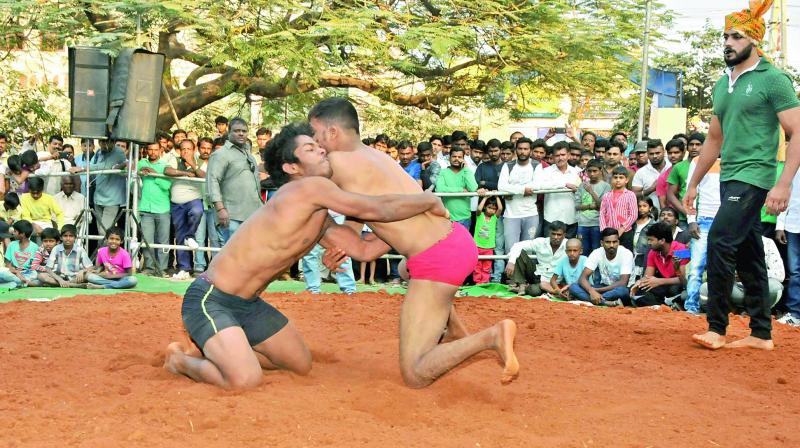Hyderabad: Kushti battles for life

HYDERABAD: Clad in loincloth, a group of teenagers warm up by climbing long ropes tied to the ceiling as other younger boys look on. One of them picks up an iron ring (hasil) weighing about 100 kg and puts it around his neck, while another trainee walks about normally with the massive weight hanging from his neck.
This is the scene at one of the biggest Akhadas (wrestling schools) in the Old City. The ancient Indian style of wrestling ‘kushti’ is taught and practiced at the Akhadas by children aged between 10 and 16 years.
The sport has been in vogue for the past may decades in Akhadas located in Dhoolpet, Begum Bazaar, Barkas and a few other parts of the Old City. The Pahelwans – the Kushti professional – come from various backgrounds. “Health-conscious educated youth are keen to learn and practise the sport. Fitness matters most to them, apart from the zeal of participating and winning at an event,” says Abdullah Bin Mohd Bamas, head of Bamas Akhada at Barkas in Old City.
The older parts of the city are home to several mud-pit Akhadas set up by well-known Pahelwans who wrestled at championships and won titles like Telangana Kesari, Telangana State Champions, Hyderabad Kesari and others. Boys undergo ‘zor’ (practice) everyday, and learn ‘daavs’ (techniques) from their ustad.
Customary methods like dand (similar to dips), baithak (squats) with hasil (iron ring) and rassa (rope) are some of the traditional exercises. Every day, the trainers get the sportsmen to level the red mud ground with spades for friendly ‘kushti’ in the Akhadas.
The regimen is rigorous. The routine starts at 6 am in winter and an hour earlier in summer. There are a set of rules to adhere to, a premium on desi food and abstinence from sex or sensuous thoughts.
“Hard work makes a man perfect. That is why we make the students practise so regularly. There are no breaks for a wrestler. Sportsmen spend about two-three hours learning and perfecting techniques every day. We consider it a sacred sport, so no one enters the practice arena without taking a bath,” says Mr Abdullah.
If not at the local Akhadas, some youngsters from affluent families of Pahelwans visit neighbouring Maharashtra for training. A few also participate in championships in Haryana, Delhi, Uttar Pradesh along with Maharashtra round the year.
Nevertheless, like many traditions in the rapidly modernising country, kushti too faces the threat of getting left behind. Though it remains popular for now, not many new Akhadas are opening. The numbers are dwindling fast.
“Despite putting in a lot of effort, a pahelwan does not land a good job. Except a few who got into the police force, not many have permanent jobs,” says Osman Al Hajri, of Taleem Amlapur.
He worries about the future of the sport. “With little assistance for the boys not many are coming forward barring those from rich families. A pahelwan needs a nutritious diet and then it takes money to travel to far off places to participate in competitions. Everybody can’t afford that,” Mr Osman says.
Wrestling was a very popular sport in the Nizam era. However, there were very few local wrestling schools then. “The Nawabs invited wrestlers from other provinces for competitions. The winners were rewarded and sent,” says Mr Abdullah Bamas.

